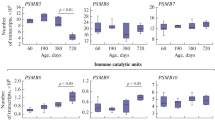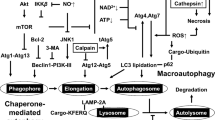Summary
By using mini-units of tissue and protease inhibitors in short term incubation (0–180 min), we studied the role of proteolysis for ongoing DNA replication in the developing rat cerebral cortex. The protease inhibitors TLCK, TPCK, PMSF, MG-132 and PSI markedly inhibited DNA synthesis. The inhibitory effects were concentration-dependent and of early onset (within 60 min). The most selective proteasome inhibitors lactacystin and clasto-lactacystin-β-lactone as well as the calpain inhibitor I and II had no or minimal effects on DNA synthesis. Only high concentrations of calpain inhibitor I (≥ 250 μM) and calpain inhibitor II (≥ 500 μM) gave a DNA synthesis inhibition. These results suggest that (1) ongoing DNA replication is regulated by proteolysis and (2) the proteolytic pathways involved are neither the proteasome nor the calpains.






Similar content being viewed by others
References
Deshaies RJ (1995) Make it or brake it: the role of ubiquitin-dependent proteolysis in cellular regulation. Trends Cell Biol 5:428–434 doi:10.1016/S0962-8924(00)89102-3
Etlinger JD, Goldberg AL (1997) A soluble ATP-dependent proteolytic system responsible for the degradation of abnormal proteins in reticulocytes. Proc Natl Acad Sci U S A 74:54–58 doi:10.1073/pnas.74.1.54
Goldberg AL (1992) The mechanism and functions of ATP-dependent proteases in bacterial and animal cells. Eur J Biochem 203:9–23 doi:10.1111/j.1432–1033.1992.tb19822.x
Hershko A, Ganoth D, Sudakin V, Dahan A, Cohen LH, Luca FC, Ruderman JV, Eytan E (1994) Components of a system that ligates cyclin to ubiquitin and their regulation by the protein kinase cdc2. J Biol Chem 269:4940–4946
Wiertz EJHJ, Jones TR, Sun L, Bogyo M, Geuze HJ, Ploegh HL (1996) The human cytomegalovirus US11 gene product dislocates MHC class I heavy chains from the endoplasmic reticulum to the cytosol. Cell 84:769–779 doi:10.1016/S0092-8674(00)81054-5
Rock KL, Gramm C, Rothstein L, Clark K, Dick L, Hwang D, Goldberg AL (1994) Inhibitors of the proteasome block the degradation of most cell proteins and the generation of peptides presented on MHC class. Mol Cell 78:761–771
Yang Y, Kitagaki J, Wang H, Hou DX, Perantoni AO (2008) Targeting the ubiquitin–proteasome system for cancer therapy. Cancer Sci 100:24–28
Orlowsky M (1990) The multicatalytic proteinase complex, a major extralysosomal proteolytic system. Biochemistry 28:9270–9278 doi:10.1021/bi00450a006
Sterz J, von Metzler I, Hahne JC, Lamottke B, Rademacher J, Heider U, Terpos E, Sezer O (2008) The potential of proteasome inhibitors in cancer therapy. Expert Opin Investig Drugs 17:879–895 doi:10.1517/13543784.17.6.879
Devoy A, Soane T, Welchman R, Mayer RJ (2005) The ubiquitin–proteasome system and cancer. Essays Biochem 41:187–203 doi:10.1042/EB0410187
Elledge SJ (1996) Cell cycle checkpoints: preventing an identity crisis. Science 274:1664–1672 doi:10.1126/science.274.5293.1664
Harper JW, Elledge SJ (2007) The DNA damage response: ten years after. Mol Cell 28:739–745 doi:10.1016/j.molcel.2007.11.015
King RW, Deshaies RJ, Peters J-M, Kirschner MW (1996) How proteolysis drives the cell cycle. Science 274:1652–1659 doi:10.1126/science.274.5293.1652
Song MS, Song SJ, Kim SJ, Nakayama K, Nakayama KI, Lim DS (2008) Skp2 regulates the antiproliferative function of the tumor suppressor RASSF1A via ubiquitin-mediated degradation at the G1-S transition. Oncogene 27:3176–3185 doi:10.1038/sj.onc.1210971
van Leuken R, Clijsters L, Wolthuis R (2008) To cell cycle, swing the APC/C. Biochim Biophys Acta 1786:49–59
Yew PR, Kirschner MW (1997) Proteolysis and DNA replication: the CDC34 requirement in the Xenopus egg cell cycle. Science 277:1672–1676 doi:10.1126/science.277.5332.1672
Yakisich JS, Sidén Å, Idoyaga Vargas V, Eneroth P, Cruz M (1999) Early effects of protein kinase modulator on DNA synthesis in rat cerebral cortex. Exp Neurol 159:164–176 doi:10.1006/exnr.1999.7121
Yakisich JS, Sidén Å, Idoyaga Vargas V, Eneroth P, Cruz M (1998) Fast and sensitive method for simultaneous measurement of cell proliferation rate and drug sensitivity in rat cerebral cortex.151:194–202
Labarca C, Paigen K (1980) A simple, rapid, and sensitive DNA assay procedure. Anal Biochem 102:344–352 doi:10.1016/0003-2697(80)90165-7
Jones E (1991) Tackling the protease problem in Saccharomyces cerevisiae. Methods Enzymol 194:428–453 doi:10.1016/0076-6879(91)94034-A
Altman J, Das GD (1966) Autoradiographic and histopathological studies of postnatal neurogenesis. I. A longitudinal investigation of the kinetics, migration and transformation of cells incorporating tritiated thymidine in neonate rats, with special reference to postnatal neurogenesis in some brain regions. J Comp Neurol 126:337–390 doi:10.1002/cne.901260302
Tanaka K, Li K, Ichihara A, Waxman L, Goldberg AL (1986) A high molecular weight protease in the cytosol of rat liver. 1. Purification, enzymological properties and tissue distribution. J Biol Chem 261:15197–15203
Mengual E, Aritzi P, Rodrigo J, Gimenez-Amaya JM, Castano JG (1996) Immunohistochemical distribution and electron microscopic subcellular localization of the proteasome in the rat CNS. J Neurosci 16:6331–6341
Vilenchik MM, Tretjak TM (1977) Evidence for unscheduled DNA synthesis in rat brain. J Neurochem 29:1159–1161 doi:10.1111/j.1471-4159.1977.tb06526.x
Merits I, Cain J (1969) Rapid loss of labeled DNA from rat brain due to radiation damage. Biochim Biophys Acta 174:315–321
Dick LR, Cruikshank AA, Destree AT, Grenier L, McCormack TA, Melandri FD, Nunes SL, Palombella VJ, Parent LA, Plamondon L, Stein RL (1997) Mechanistic studies on the inactivation of the proteasome by lactacystin in cultured cells. J Biol Chem 272:182–188 doi:10.1074/jbc.272.20.13372
Dick LR, Cruiskshank AA, Grenier L, Melandri FD, Nunes SL, Stein RL (1996) Mechanistic studies on the inactivation of the proteasome by lactacystin. A central role for clasto-lactacystin-B-lactone. J Biol Chem 271:7273–7276 doi:10.1074/jbc.271.13.7273
Fenteany G, Schreiber SL (1998) Lactacystin, proteasome function, and cell fate. J Biol Chem 273:8545–8548 doi:10.1074/jbc.273.15.8545
Fenteany G, Standaert RF, Lane WS, Choi S, Corey EJ, Schreiber SL (1995) Inhibition of proteasome activities and subunit-specific amino-terminal threonine modification by lactacystin. Science 268:726–731 doi:10.1126/science.7732382
Craiu A, Gaczynska M, Akopian T, Gramm C, Fenteany G, Goldberg AL, Rock K (1997) Lactacyctin and clasto-lactacystin B-lactone modify multiple proteasome B-subunits and inhibit intracellular protein degradation and major histocompatibility complex class I antigen presentation. J Biol Chem 272:23437–23445 doi:10.1074/jbc.272.20.13437
Jensen TJ, Loo MA, Pind S, Williams DB, Goldberg AL, Riordan JR (1995) Multiple proteolytic systems, including the proteasome, contribute to CFTR processing. Cell 83:129–135 doi:10.1016/0092–8674(95)90241–4
Mori S, Tanaka K, Omura S, Saito Y (1995) Degradation process of ligand-stimulated platelet-derived growth factor B-receptor involves ubiquitin-proteasome proteolytic pathway. J Biol Chem 270:29447–29452 doi:10.1074/jbc.270.52.30862
Honda T, Yasutake K, Nihonmatsu N, Mercken M, Takahashi H, Murayama O, Murayama M, Sato K, Omori A, Tsubuki S (1999) Dual role of proteasome in the metabolism of presenilin 1. J Neurochem 72:255–261 doi:10.1046/j.1471-4159.1999.0720255.x
Schow SR, Joly A (1997) N-acetyl-leucinyl-leucinyl-norleucinal inhibits lipopolysaccharide-induced BF-kB activation and prevents TNF and IL-6 synthesis in vivo. Cell Immunol 175:199–202 doi:10.1006/cimm.1996.1061
Dubiel W, Pratt G, Ferrell K, Rechsteiner M (1992) Purification of an 11 S regulator of the multicatalytic protease. J Biol Chem 267:22369–22377
Lee DH, Goldberg AF (1996) Selective inhibitors of the proteasome-dependent and vacuolar pathways of protein degradation in Saccharomyces cerevisiae. J Biol Chem 271:27280–27284 doi:10.1074/jbc.271.44.27280
Lee DH, Goldberg AL (1998) Proteasome inhibitors: valuable new tools for cell biologists. Trends Cell Biol 8:397–403 doi:10.1016/S0962-8924(98)01346-4
Grimm LM, Goldberg AL, Poirier GJ, Schwartz LM, Osborne BA (1996) Proteasomes play an essential role in thymocyte apoptosis. EMBO J 15:3835–3844
Lu Q, Mellgren RL (1996) Calpain inhibitors and serine protease inhibitors can produce apoptosis in HL-60 cells. Arch Biochem Biophys 334:175–181 doi:10.1006/abbi.1996.0443
Choi SH, Lee SJ, Nguyen P, Jang JS, Lee J, Wu M-L, Takano E, Maki M, Henkart PA, Trepel JB (1997) Regulation of cyclin D1 by calpain protease. J Biol Chem 272:28479–28484 doi:10.1074/jbc.272.45.28479
Sarin A, Adams DH, Henkart PA (1993) Protease inhibitors selectively block T cell-triggered programmed cell death in a murine T cell hybridoma and activated peripheral T cells. J Exp Med 178:1693–1700 doi:10.1084/jem.178.5.1693
Minnaugh EG, Chen HY, Davie JR, Celis JE, Neckers K (1997) Rapid deubiquitination of nucleosomal histones in human tumor cells caused by proteasome inhibitors and stress response inducers: effects on replication, transcription, translation, and the cellular stress response. Biochemistry 36:14418–14429 doi:10.1021/bi970998j
Campisi J, Morreo G, Pardee AB (1984) Kinetic of G1 transit following brief starvation for serum factors. Exp Cell Res 152:459–466 doi:10.1016/0014-4827(84)90647-5
Zetterberg A, Larsson O (1985) Kinetic analysis of regulatory events in G1 leading to proliferation or quiescence of Swiss 3T3 cells. Proc Natl Acad Sci U S A 82:5365–5369 doi:10.1073/pnas.82.16.5365
Pardee AB (1989) G1 events and regulation of cell proliferation. Science 246:603–608 doi:10.1126/science.2683075
Diehl JA, Cheng M, Roussel MF, Sherr CJ (1998) Glycogen synthase kinase-3beta regulates cyclin D1 proteolysis and subcellular localization. Genes Dev 12:3499–3511 doi:10.1101/gad.12.22.3499s
Sanchez M, Calzada A, Bueno A (1999) The cdc6 protein is ubiquitinated in vivo for proteolysis in Saccharomyces cerevisiae. J Biol Chem 26:9092–9097 doi:10.1074/jbc.274.13.9092
Baum B, Nishitani H, Yanow S, Nurse P (1998) Cdc18 transcription and proteolysis couple S phase to passage through mitosis. EMBO J 17:5689–5698 doi:10.1093/emboj/17.19.5689
Costanzo V, Avvedimento EV, Gottesman ME, Gautier J, Grieco D (1999) Protein kinase A is required for chromosomal DNA replication. Curr Biol 9:903–906 doi:10.1016/S0960-9822(99)80395-9
Mahbudani HM, Chong JPJ, Chevalier S, Thommes P, Blow JJ (1997) Cell cycle regulation of the replication licensing system: involvement of a Cdk-dependent inhibitor. J Cell Biol 136:125–135 doi:10.1083/jcb.136.1.125
Coverley D, Wilkinson HR, Madine MA, Mills AD, Laskey RA (1998) Protein kinase inhibition in G2 causes mammalian mcm proteins to reassociates with chromatin and restores ability to replicate. Exp Cell Res 238:63–69 doi:10.1006/excr.1997.3829
Byrnes KRFA (2007) Role of cell cycle proteins in CNS injury. Neurochem Res 32:1799–1807 doi:10.1007/s11064-007-9312-2
Dahlmann B (2007) Role of proteasomes in disease. BMC Biochem 8:S3 doi:10.1186/1471-2091-8-S1-S3
Yew EH, Cheung NS, Choy MS, Qi RZ, Lee AY, Peng ZF, Melendez AJ, Manikandan J, Koay ES, Chiu LL (2005) Proteasome inhibition by lactacystin in primary neuronal cells induces both potentially neuroprotective and pro-apoptotic transcriptional responses: a microarray analysis. J Neurochem 4:943–956 doi:10.1111/j.1471-4159.2005.03220.x
Acknowledgements
This work was supported by grants from the Swedish Research Council, the Karolinska Institute and the Stockholms Läns Landsting.
Author information
Authors and Affiliations
Corresponding author
Electronic supplementary material
Below is the link to the electronic supplementary material.
Table S1
Proteases inhibited by TLCK, TPCK, PMSF, MG-132, PSI, LC, CLC, Ca I I and Ca I II. A) Reported IC50 for the proteasome and calpains. B) Reported IC50 for the other cysteine and serine proteases (172 kb).
Rights and permissions
About this article
Cite this article
Yakisich, J.S., Sidén, Å. & Cruz, M. Ongoing DNA synthesis in the rat cerebral cortex is regulated by a proteolytic pathway independent of the proteasome and calpains. Invest New Drugs 28, 242–250 (2010). https://doi.org/10.1007/s10637-009-9238-4
Received:
Accepted:
Published:
Issue Date:
DOI: https://doi.org/10.1007/s10637-009-9238-4




